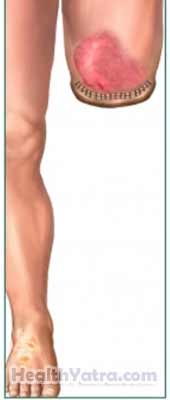Amputation General Surgery
An amputation is a surgery to remove a body part. It is removed because of disease or damage.

أسباب هذا الإجراء
An amputation is typically done for one of the following reasons:
- Peripheral arterial disease (PAD) causing:
- الغرغرينا
- Untreatable pain
- Severe soft tissue infection
- Severe trauma that can not be repaired
- Complications of diabetes
- Untreatable bone infection ( osteomyelitis)
- Malignant tumor
- Congenital deformity (present at birth)
- Severe frostbite
- Complications of connective tissue diseases, such as:
- Lupus
- تصلب الجلد
المضاعفات المحتملة
If you are planning to have an amputation, your سيقوم الطبيب بمراجعة القائمة من المضاعفات المحتملة، والتي قد تشمل:
- Poor healing at amputation site, resulting in the need for a higher level of amputation
- Skin breakdown
- العدوى
- نزيف
- Swelling at surgical site
- Phantom limb pain —feeling pain in amputated limb area
- Phantom sensation—feeling that amputated limb is still there
- Blood clots
- Complications of anesthesia
بعض العوامل التي قد تزيد من خطر المضاعفات تشمل:
- أمراض الأوعية الدموية الطرفية
- مرض السكري
- العدوى
- Prolonged immobility
- مرض قلبي
- التدخين أو أمراض الرئة
- اضطرابات تخثر الدم
- Certain medicines (eg, steroids)
ما يمكن توقعه
قبل الإجراء
Your amputation may be planned. In this case, your doctor will review with you how it is done and what to expect. An emergency amputation may need to be done. This can happen because of trauma or life-threatening infection. In this case, you may not have this preparation.
Depending on the injury and location, your doctor may do some of the following before your surgery:
- X-rays —a test that uses radiation to take a picture of structures inside the body, especially bones
- الأشعة المقطعية — نوع من الأشعة السينية التي تستخدم الكمبيوتر لالتقاط صور للهياكل داخل الجسم
- التصوير بالرنين المغناطيسي – اختبار يستخدم الموجات المغناطيسية لالتقاط صور للهياكل داخل الجسم
- Bone scan to check for infection
- Tissue cultures
- تحاليل الدم
- Heart evaluation
- Preoperative antibiotics
- Tests to evaluate blood flow in the part of the body that is being amputated
Leading up to your surgery:
- Arrange for a ride home from the hospital.
- Arrange for help at home after your surgery.
- Follow instructions for eating before surgery—usually nothing after midnight.
- You may be asked to use an antibacterial soap the morning of your surgery.
التخدير
This will depend on the body part operated on. You may receive:
- التخدير العام - سوف تكون نائما.
- Local anesthesia—A specific area will be numbed.
- Spinal anesthesia —Your lower body will be numb.
الوصف الداخلي
An incision will be made into the skin of the affected limb or limb part. If needed, the muscles will also be cut. Blood vessels will be tied off or sealed to prevent bleeding. The bone will then be cut through. The diseased or damaged body part will be removed.
Muscle will be pulled over the bone. It will be sutured in place there. The remaining skin will be pulled over the muscle. The skin will be sewn to form a stump. A sterile dressing will be placed over the incision.
If severe infection is involved, the incision may be left open to heal.
كم من الوقت سيستغرق ؟
This procedure can take 20 minutes to several hours. The length will depend on the type of amputation being done.
كم هو مؤلم ؟
During the surgery, anesthesia will block any pain. After surgery, you will feel pain as you begin to heal. Your doctor will give a medicine to help manage pain. You may feel phantom pain, which is a feeling of pain in the amputated portion of the limb that is no longer present. If you do, tell your doctor so it can be treated.
متوسط الإقامة في المستشفى
Your hospital stay will depend on the type of amputation you had. Typically:
- Foot or toe amputation: 2-7 days
- Leg amputation: 2 days to 2 weeks
- Upper extremity: 7-12 days
- Finger amputation: 0-1 day
Your doctor may choose to keep you longer if complications arise.
رعاية ما بعد العملية
في المستشفى
After surgery, you can expect some of the following:
- The area involved will be elevated. This will decrease swelling.
- Your limb will be dressed in bulky dressing, elastic bandage, or cast.
- You will be encouraged to get up and walk as soon as possible.
- Physical therapy will begin within a day or two of surgery. It will focus on improving strength and mobility.
- You may wear a cast or special shoe for toe/foot amputations.
- You may be given certain medicines. This may include antibiotics or blood thinners.
- You will be fitted with a prosthesis as soon as your wound has healed.
في البيت
Stitches will be removed within a few weeks of surgery. When you return home, do the following to help ensure a smooth recovery:
- If you smoke, quit. Smoking can interfere with healing.
- Follow the instructions for keeping your incision clean .
- Follow instructions on how to care for your prosthesis.
- Counseling may be recommended for the emotional trauma of an amputation.
- Attend follow up appointments with your doctor. They will make sure you are healing well.
- استشر طبيبك حول الأدوية التي يجب تناولها في المنزل.
اسأل طبيبك أيضًا عن الوقت المناسب للاستحمام أو الاستحمام أو النقع في الماء.
استدعاء الطبيب
بعد مغادرة المستشفى ، اتصل بطبيبك في حالة حدوث أي مما يلي:
- علامات الإصابة, بما في ذلك حمى وقشعريرة
- Redness, swelling, increasing pain, excessive bleeding, or discharge from the incision sites
- Increasing or excessive pain
- سعال أو ضيق في التنفس أو ألم في الصدر
- Severe nausea and vomiting
في حالة الطوارئ ، اتصل على المساعدة الطبية على الفور.
